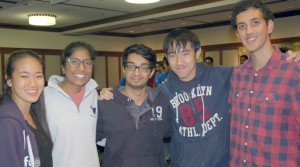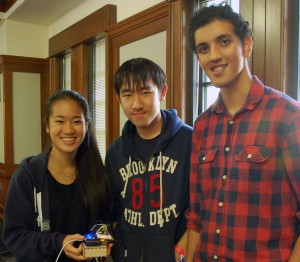
iAlert Team: Rebecca Lee (Rice) and UT teammates Aashima Garg, Nav Saini, Brian Wang and Pranav Harathi.
The iAlert team at HackRice included four electrical engineering students from the University of Texas at Austin and a sophomore dual computer science and electrical engineering major from Rice University. The product they designed and prototyped at HackRice was a button that sends a simple “safe/unsafe” message to the user’s five closest Facebook friends.
The device could be used to provide reassurance or to notify friends if the user feels threatened. Pranav Harathi, one of the UT students, said, “if you are in or near an adverse situation, say for example a fire or earthquake, you could let your family know you were safe.”
“Or if you are traveling, whether you are the pilot of a private plane or a passenger in a commercial craft, you can let your family and friends know you landed safely, even if your phone is still turned off,” said another UT team member, Brian Wang.
Harathi and Wang both worked on the hardware part of the product at HackRice. Aashima Garg of UT and Rebecca Lee of Rice University worked on the Android software, and Nav Saini of UT focused on connecting the software with Facebook’s Messenger bot.
“Regardless of the outcome, we got a lot out of this hackathon,” said Saini. “In particular, we learned how to adapt to a changing environment.”
Harathi agreed. “The hardware doesn’t always react the way you think it will.” Wang picked up the story, “We brought our own hardware, an Arduino and a WiFi Shield, but we still had to look up and read a lot of documentation online as we attempted to connect the three platforms. In iAlert, the WiFi Shield is triggered by the Arduino, a mini computer, to send out the signal to the Messenger bot: ‘feeling safe’ or ‘feeling unsafe.’”
Like many of the teams participating in HackRice, the iAlert group discovered connections. Saini and Harathi both attended Plano West Senior High School (in a senior class of 1500 people), but never had a course together until they arrived at UT. Wang and Garg were also in some of Saini and Harathi’s freshman classes at UT, but none of the four students met in those classes. “The EE major at UT is really large,” said Garg. “The three guys were all on the same team at an iOS boot camp called Codepath last spring.”
“Aashima was on another team,” said Saini, “but all of us had a lot in common, like the courses we were taking, so we worked on some side projects and kept in touch over the summer.”
Garg met Lee over that summer, when both interned at Facebook. She said, “Rebecca and I were in the same freshman program, FBU. We trained together and were both working on Android applications over the summer, and we stayed in touch.” That same summer, Harathi interned at Dun and Bradstreet, Nav worked for a local startup, and Wang embedded applications for a small company in College Station.
This semester, the four UT students have most of their EE classes together again, but after their summer experiences they realized they were missing practical application experience. Garg said, “We decided to take a road trip to Houston for HackRice, and I knew Rebecca would be here and was excited to see her because we had similar interests in virtual reality.”
Lee said, “I was on a different team when Aashima texted me to ask about an Android problem she was having. My team decided not to pursue our original project, so I was free to tag team with Aashima to solve the Android issues for her team.”
The team as a whole felt the learning environment in HackRice was important to developing their practical skills. Wang said, “In terms of the experience we got, developing a product that works, we would never get to do something like this in a class project.”
“Using three separate platforms, and creating something for the greater good, that’s the kind of work you’d do in industry,” said Nav.
Wang agreed, and joked about their growing camaraderie. He said, “When you struggle together you get to know each other really well. You definitely bond when you work together to meet a tight deadline for a new product.”
Garg added, “As far as technology, we learned a lot about programming, debugging, a lot about the platform. We didn’t even know if it was possible for the Android to pull info on user action in order to determine the user’s top five friends on Facebook.”
Lee said one of her most important lessons was learning how to efficiently troubleshoot problems. “Test cases – that was a skill we really developed,” she said. “Testing all the possibilities in order to reach the root problem and find a solution – that is not something we cover in my classes.”
As the hackathon wrapped up, only Garg had committed to her next internship. “I’m definitely headed back to Facebook,” she said. Lee said she was still interviewing but was narrowing her choices. “I’m headed to the Grace Hopper Celebration for Women,” she said, “and I’ll probably make a decision by November.
Wang, Nav, and Harathi expect to use the skills they developed over the 36-hour hackathon, as well as their project experience, as they enter the next phase of interviews for their own internships.
